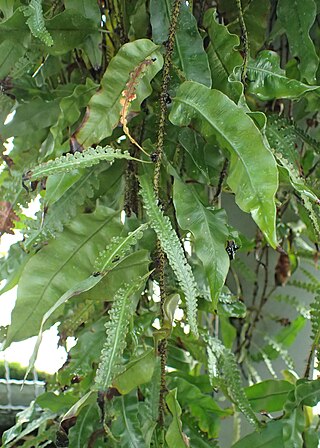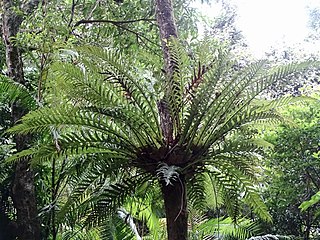
Polypodiaceae is a family of ferns. In the Pteridophyte Phylogeny Group classification of 2016, the family includes around 65 genera and an estimated 1,650 species and is placed in the order Polypodiales, suborder Polypodiineae. A broader circumscription has also been used, in which the family includes other families kept separate in PPG I. Nearly all species are epiphytes, but some are terrestrial.

Oleandra is a genus of ferns. In the Pteridophyte Phylogeny Group classification of 2016, it is the only genus in the family Oleandraceae, which is placed in suborder Polypodiineae, order Polypodiales. Alternatively, the family may be placed in a very broadly defined family Polypodiaceae sensu lato as the subfamily Oleandroideae.

Phlebodium aureum is an epiphytic fern native to tropical and subtropical regions of the Americas.

Phlebodium is a small genus of ferns in the family Polypodiaceae, subfamily Polypodioideae, according to the Pteridophyte Phylogeny Group classification of 2016 (PPG I). It is native to tropical and subtropical regions of the Americas. Its species were formerly included in Polypodium.

Polypodium vulgare, the common polypody, is an evergreen fern of the family Polypodiaceae. Polypodium vulgare is an allotetraploid species, believed to have arisen by chromosome doubling of a sterile diploid hybrid between two ferns which are not known in Europe. The fern's proposed parents are the northern Asian and northern North American Polypodium sibiricum and western North American Polypodium glycyrrhiza. Biochemical data point to a species from eastern Asia as the second possible parent. The name is derived from poly (many) and pous, podos . Polypody has traditional uses in cooking for its aroma and sweet taste, and in herbal medicine as a purgative and vermifuge.

Polypodium glycyrrhiza, commonly known as licorice fern, many-footed fern, and sweet root, is a summer deciduous fern native to western North America, where it is found in shaded, damp locations.

Zealandia pustulata is a species of fern native to eastern Australia and New Zealand. It is commonly referred to as kangaroo fern because of its mature leaves tend to resemble the shape of a kangaroo foot. It is also referred to as hound's tongue, and as kōwaowao and pāraharaha in Māori.

Aglaomorpha is a genus of ferns in the subfamily Drynarioideae of the family Polypodiaceae. The Pteridophyte Phylogeny Group classification of 2016 uses this genus name, while other sources use Drynaria to include Aglaomorpha. Species are commonly known as basket ferns. As circumscribed in PPG I, the genus contains around 50 species.

Drynarioideae is a subfamily of the fern family Polypodiaceae in the Pteridophyte Phylogeny Group classification of 2016 (PPG I). The subfamily is also treated as the tribe Drynarieae within a very broadly defined family Polypodiaceae sensu lato. In either case, it includes the previously separated tribe Selligueeae.

Polypodium cambricum, the southern polypody, limestone polypody, or Welsh polypody, is a species of fern in the family Polypodiaceae, native to southern and western Europe where it grows on shady rocks, near the coasts of the Mediterranean Basin and in the mountains of Atlantic Europe. It is a spreading, terrestrial, deciduous fern growing to 60 centimetres (24 in) tall, with pinnate fronds. The sori are yellow in winter.
Lepisorus squamatus is a species of fern known only from Vietnam and from Guangxi Province in southern China. The plant is herbaceous, spreading by rhizomes. The leaves are simple, elliptical, and the sori are round, on the underside of the leaves. The spores are white.

Aglaomorpha quercifolia, commonly known as the oakleaf fern or oakleaf basket fern, is a species of Aglaomorpha in the family Polypodiaceae. Other common names for the fern are pakpak lawin, gurar, koi hin, ashvakatri, kabkab, kabkaban, or uphatkarul.
Archigrammitis is a genus of ferns in the family Polypodiaceae, subfamily Grammitidoideae, according to the Pteridophyte Phylogeny Group classification of 2016 (PPG I). It is known from Malesia and Polynesia.

Polypodium is a genus of ferns in the family Polypodiaceae, subfamily Polypodioideae, according to the Pteridophyte Phylogeny Group classification of 2016 (PPG I). The genus is widely distributed throughout the world, with the highest species diversity in the tropics. The name is derived from Ancient Greek poly (πολύ) "many" + podion (πόδιον) "little foot", on account of the foot-like appearance of the rhizome and its branches. They are commonly called polypodies or rockcap ferns, but for many species unique vernacular names exist.
Paraselliguea is a genus of ferns in the subfamily Drynarioideae of the family Polypodiaceae according to the Pteridophyte Phylogeny Group classification of 2016 (PPG I), with a single species Paraselliguea leucophora.
Bosmania is a genus of ferns in the family Polypodiaceae, subfamily Microsoroideae, erected in 2019. As of February 2020, the genus was not accepted by some sources.
Dendroconche annabellae is a species of fern in the family Polypodiaceae, subfamily Microsoroideae. It is endemic to Papua New Guinea.

Aglaomorpha rigidula is a species of tropical fern in genus Aglaomorpha widely distributed throughout Southeast Asia, from Southwest China to Queensland and New South Wales in Australia. Growing as an epiphyte or lithophyte, its green fronds are up to 1.22 metres in length. This fern develops two types of fronds, some of which near the base of the plant are shorter, sterile, and rust-colored which form a basket-like shape that trap moisture and organic components that nourish it. Especially in colder weather, this basket acts as prime habitat for animals such as the Amethystine python.

Aglaomorpha bonii is a species of subtropical fern native to Southeast Asia. Growing as an epiphyte or lithophyte, its rhizome is covered in dry, paper-like fronds while the larger fronds are fertile and bear spores. This fern has long been used in traditional medicine in Vietnam to treat a variety of ailments, and in scientific research, compounds from the plant have demonstrated antibacterial and antioxidant properties.

Aglaomorpha willdenowii is a species of subtropical fern native to the islands of Comoros, Madagascar, and Mauritius. Drynarioid ferns are largely native to Asia and Oceania, but A. willdenowii is the only species of fern in the genus native to Madagascar. Like other Aglaomorpha, its caudex is covered in dry, scale-like sterile fronds and fine hairs, while the larger green fronds are the fertile ones bearing spores.














